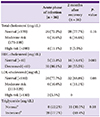1. Kazar J, Mongiellova V, Gajdos M, Kovacova E, Tomka J, Slysko R, Fridrich V. Anti-cytomegalovirus antibodies and other atherosclerosis risk factors in patients with cardiovascular diseases. J Geriatr Cardiol. 2007; 4:131–134.
2. Memon RA, Staprans I, Noor M, Holleran WM, Uchida Y, Moser AH, Feingold KR, Grunfeld C. Infection and inflammation induce LDL oxidation in vivo. Arterioscler Thromb Vasc Biol. 2000; 20:1536–1542.

3. O'Connor S, Taylor C, Campbell LA, Epstein S, Libby P. Potential infectious etiologies of atherosclerosis: a multifactorial perspective. Emerg Infect Dis. 2001; 7:780–788.
4. Kanbay M, Gür G, Yücel M, Yilmaz U, Boyacioğlu S. Does eradication of
Helicobacter pylori infection help normalize serum lipid and CRP levels? Dig Dis Sci. 2005; 50:1228–1231.

5. Khovidhunkit W, Kim MS, Memon RA, Shigenaga JK, Moser AH, Feingold KR, Grunfeld C. Effects of infection and inflammation on lipid and lipoprotein metabolism: mechanisms and consequences to the host. J Lipid Res. 2004; 45:1169–1196.

6. Van Lenten BJ, Reddy ST, Navab M, Fogelman AM. Understanding changes in high density lipoproteins during the acute phase response. Arterioscler Thromb Vasc Biol. 2006; 26:1687–1688.

7. Nassaji M, Ghorbani R. Plasma lipid levels in patients with acute bacterial infections. Turk J Med Sci. 2012; 42:465–469.

8. Khovidhunkit W, Memon RA, Feingold KR, Grunfeld C. Infection and inflammation-induced proatherogenic changes of lipoproteins. J Infect Dis. 2000; 181:Suppl 3. S462–S472.

9. Apostolou F, Gazi IF, Logas K, Tellis CC, Tselepis AD, Liberopoulos EN, Elisaf M. Acute infection with Epstein–Barr virus is associated with atherogenic lipid changes. Atherosclerosis. 2010; 212:607–613.

10. Macsween KF, Crawford DH. Epstein-Barr virus-recent advances. Lancet Infect Dis. 2003; 3:131–140.

11. Azizi F, Rahmani M, Madjid M, Allahverdian S, Ghanbili J, Ghanbarian A, Hajipour R. Serum lipid levels in an Iranian population of children and adolescents: Tehran lipid and glucose study. Eur J Epidemiol. 2001; 17:281–288.
12. Anonymous . National Cholesterol Education Program: highlights of the repot of the expert panel on blood cholesterol levels in children and adolescents. US Department of health and human services, public health service. National institute of health, national heart, lung, and blood institute. J Am Osteopath Assoc. 1992; 92:380–388.
13. Tershakovec AM, Daniel J. Disorders of lipoprotein metabolism and transport. In : Behrman RE, Kliegman RM, Jenson HB, editors. Nelson textbook of pediatrics. 17th ed. Philadelphia, PA: Saunders;2004. p. 445–459.
14. Khosla SN, Goyle N, Seth RK. Lipid profile in enteric fever. J Assoc Physicians India. 1991; 39:260–262.
15. Alvarez C, Ramos A. Lipids, lipoproteins and apoproteins in serum during infections. Clin Chem. 1986; 32:142–145.
16. Burger D, Dayer JM. High-density lipoprotein-associated apolipoprotein A-I: the missing link between infection and chronic inflammation? Autoimmun Rev. 2002; 1:111–117.

17. Gazi IF, Elisaf MS. Effect of infection on lipid profile: focus on Epstein–Barr virus. Clin Lipidol. 2010; 5:607–610.

18. Volanen I, Raitakari OT, Vainionpää R, Arffman M, Aarnisalo J, Anglé S, Kallio K, Simell O. Serum lipid profiles poorly correlate with
Chlamydia pneumoniae, Helicobacter pylori, and cytomegalovirus seropositivity in prospectively followed-up healthy children. Arterioscler Thromb Vasc Biol. 2005; 25:827–832.

19. Işcan A, Yiğitoğlu R, Onağ A, Vurgun N, Ari Z, Ertan P, Sengil AZ. Should children with infection be tested for lipid, lipoprotein and apolipoprotein? Acta Paediatr Jpn. 1998; 40:47–51.

20. Leach CT, Sumaya CV, Harrison GJ. Epstein-Barr Virus. In : Cherry J, Demmler-Harrison G, Kaplan S, Steinbach W, Hotez P, editors. Feigin and Cherry's textbook of pediatric infectious diseases. 7th ed. Philadelphia, PA: Elsevier Press;2014. p. 1992–2015.








 PDF
PDF ePub
ePub Citation
Citation Print
Print



 XML Download
XML Download